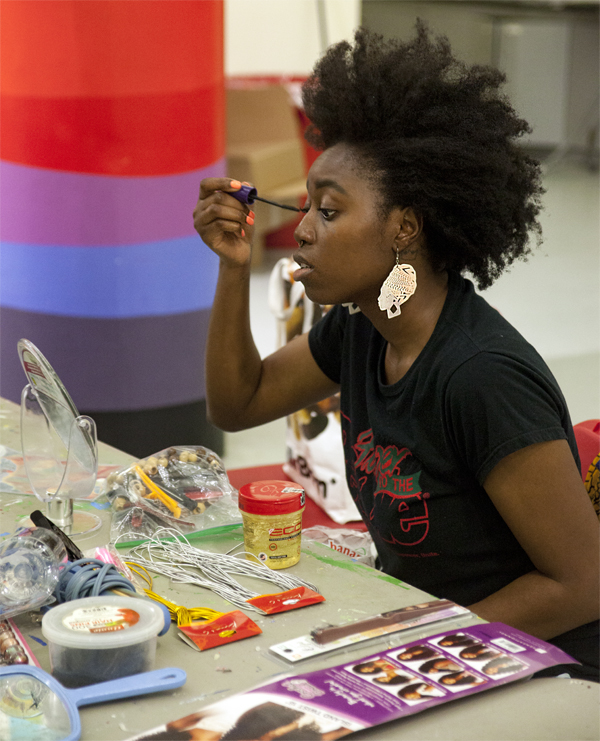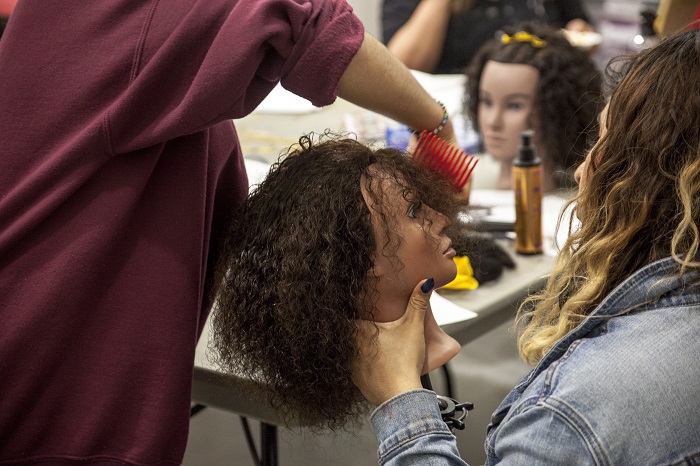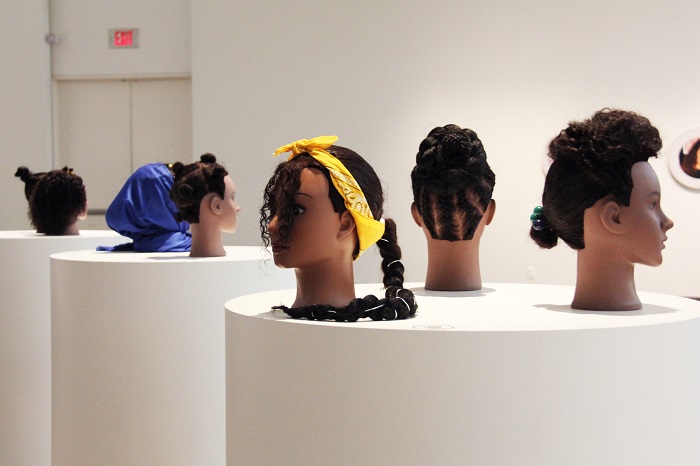Hair We Are will ignite conversations
We invited local artists and writers to interact with and reflect on our Community Arts Space projects. Here, Dr. Cheryl Thompson writes about the Youth Project: Hair We Are, presented in partnership with Art Starts and VIBE Arts. Dr. Thompson is an Assistant Professor at Ryerson University in the School of Creative Industries, and the author of Beauty in a Box: Detangling the Roots of Canada’s Black Beauty Culture.
Black hair is complicated. I wrote a book about it, and there are still many layers to the topic that I have yet to uncover. From its texture to its styling to the products, Black women have stories to share about our hair that are deeply personal. This is the subtext to the youth project, Hair We Are, a Community Arts Space project led by artist Igho Diana in partnership with Art Starts and VIBE Arts.
The project, which features self-care, hair care, and storytelling workshops facilitated by Igho, as well as an interactive exhibition at the Gardiner Museum, is intended to disrupt not just ideas about beauty and hair, but also the Museum itself.

“A lot of art spaces, museums, and galleries aren’t always welcoming to the lay person,” says Igho. “It always seems like [there’s] a particular crowd that goes to the museum or galleries and a particular set of people or cultures that are represented so the invitation to do this was really an opportunity to showcase different perspectives and different cultures and people that are [often] left out of the conversation.”
There have, in recent years, been a few attempts to bring Black hair out into the open. In 2013, in New York City’s Union Square, Antonia Opiah staged a public art exhibition that interrupted space and dispelled myths about Black hair. The aim was to explore the “tactile fascination” with Black women’s hair by gathering Black women with different hair textures and hairstyles and allowing passerby the opportunity to fondle their hair without the fear of being reprimanded. Like Opiah’s exhibition, Hair We Are is also a disruptive call-to-action meant to dispel some of the misconceptions about Black women’s hair.
“When I step out the house, I typically wear my ‘fro out and I just let it sit the way it sits. I have a particular way that I part my hair but I notice when people look at me they’re thinking, ‘Did this girl just wake up’ or ‘Did she forget to comb her hair?’ I want to tell them, no my hair looks like this on purpose; this is how my hair grows out of my head, and that’s just the way that I want to style it today,” Igho explains.

For many Black women, hair care is synonymous with identity and self-care. “Learning who you are and being aware of who you are is so important regardless of the space you’re in,” says Igho. With this in mind, the Gardiner exhibition is in the form of a contemporary beauty salon environment. It is accompanied by a hands-on Family Sunday workshop on July 14, facilitated by Igho, that aims to teach and share the importance of self-care practices.
“For Family Sunday, I curated something that is interactive with the public. I thought that making shea butter and DIY hair products would be an interesting way to pull the public in because it’s literally a part of my self-care practice.”
The idea behind the workshops is to give people a sense of what goes into making natural hair products, as well as the time and effort it takes to care for Black hair. For example, participants will learn the importance of natural oils like shea butter, which is the core ingredient in most hair oils, shampoos, and conditioners. This participatory part of Hair We Are invites people into a conversation about what’s in our hair products, and why we should care.

The interactive exhibition gives visitors an opportunity to look at different textures through photographs of Black hair and mannequin displays with different hairstyles – including some wearing hijabs. A documentary featuring Black women getting their hair done outside A Different Booklist Cultural Centre will also screen as visitors walk through Hair We Are. The aim is to engage with the displays, as well as invite visitors to ask questions about Black hair—its styling, its politics—and most importantly, the varied ways Black women use hair as a form of self-expression.
“I want people to see different visual identities that we notice on a daily basis and have conversation, have dialogue about what it means to be surrounded by people like that, those visuals, and what are some ideas that come up—what types of conversations do we have with ourselves when we see marginalized folks?” says Igho.
Hair We Are uses Black hair as a medium to talk about identity but also self-care, which for Igho is a responsibility to know yourself, and to grow yourself so that you can be of service to other people.
“It is really important that we are not just presenting what people expect or what the norm is but that we are truly connected to our identity—whatever that looks like—and [that] we’re able to show up in that identity wherever we are.”
By connecting Black hair with self-care and identity, Hair We Are promises to ignite debate, conversation, and most of all, deeper understanding about Black women’s experiences. It’s not easy to be yourself, regardless of the space that you find yourself in, but with this project, the public is literally and figuratively asked to let their hair down, and step into Black hair as a matter of being.
Images: [1] Hair We Are, 2019 [2] Hair We Are workshop at Art Starts. Photo: Raven Lam [3] Hair We Are workshop at Art Starts. Photo: Raven Lam [4] Hair We Are, 2019